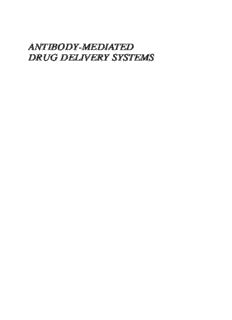
Antibody-Mediated Drug Delivery Systems: Concepts, Technology, and Applications PDF
Preview Antibody-Mediated Drug Delivery Systems: Concepts, Technology, and Applications
ANTIBODY-MEDIATED DRUG DELIVERY SYSTEMS ANTIBODY-MEDIATED DRUG DELIVERY SYSTEMS Concepts, Technology, and Applications Editedby YASHWANT PATHAK DepartmentofPharmaceuticalSciences CollegeofPharmacy UniversityofSouthFlorida Tampa,Florida SIMON BENITA TheInstituteforDrugResearchoftheSchoolofPharmacy TheHebrewUniversityofJerusalem Jerusalem,Israel AJOHNWILEY&SONS,INC.,PUBLICATION Copyright©2012byJohnWiley&Sons,Inc.Allrightsreserved. PublishedbyJohnWiley&Sons,Inc.,Hoboken,NewJersey. PublishedsimultaneouslyinCanada. Nopartofthispublicationmaybereproduced,storedinaretrievalsystem,ortransmittedinanyform orbyanymeans,electronic,mechanical,photocopying,recording,scanning,orotherwise,exceptas permittedunderSection107or108ofthe1976UnitedStatesCopyrightAct,withouteithertheprior writtenpermissionofthePublisher,orauthorizationthroughpaymentoftheappropriateper-copyfee totheCopyrightClearanceCenter,Inc.,222RosewoodDrive,Danvers,MA01923,(978)750-8400, fax(978)750-4470,oronthewebatwww.copyright.com.RequeststothePublisherforpermission shouldbeaddressedtothePermissionsDepartment,JohnWiley&Sons,Inc.,111RiverStreet, Hoboken,NJ07030,(201)748-6011,fax(201)748-6008,oronlineat http://www.wiley.com/go/permission. LimitofLiability/DisclaimerofWarranty:Whilethepublisherandauthorhaveusedtheirbestefforts inpreparingthisbook,theymakenorepresentationsorwarrantieswithrespecttotheaccuracyor completenessofthecontentsofthisbookandspecificallydisclaimanyimpliedwarrantiesof merchantabilityorfitnessforaparticularpurpose.Nowarrantymaybecreatedorextendedbysales representativesorwrittensalesmaterials.Theadviceandstrategiescontainedhereinmaynotbe suitableforyoursituation.Youshouldconsultwithaprofessionalwhereappropriate.Neitherthe publishernorauthorshallbeliableforanylossofprofitoranyothercommercialdamages,including butnotlimitedtospecial,incidental,consequential,orotherdamages. Forgeneralinformationonourotherproductsandservicesorfortechnicalsupport,pleasecontactour CustomerCareDepartmentwithintheUnitedStatesat(800)762-2974,outsidetheUnitedStatesat (317)572-3993orfax(317)572-4002. Wileyalsopublishesitsbooksinavarietyofelectronicformats.Somecontentthatappearsinprint maynotbeavailableinelectronicformats.FormoreinformationaboutWileyproducts,visitourweb siteatwww.wiley.com. LibraryofCongressCataloging-in-PublicationData: Antibody-mediateddrugdeliverysystems:concepts,technology,andapplications/editedby YashwantPathak,SimonBenita. p.;cm. ISBN978-0-470-61281-1(cloth) I.Pathak,Yashwant.II.Benita,Simon,1947- [DNLM:1. Antibodies–therapeuticuse.2. DrugDeliverySystems.3. DrugCarriers.4. Nanoparticles.QV785] 615.37–dc23 2011037603 PrintedintheUnitedStatesofAmerica 10987654321 CONTENTS CONTRIBUTORS xv PREFACE xix CHAPTER1 ANTIBODY-MEDIATEDDRUGDELIVERYSYSTEMS:GENERAL REVIEWANDAPPLICATIONS NavdeepKaur,KarthikeyanSubramani,andYashwantPathak 1 1 HistoricalPerspective 1 2 Antibodies 2 2.1 StructureofAntibodies 2 2.2 TypesofAntibodies 2 2.3 AntibodyDevelopment 3 3 AntibodyMediation 3 4 Antibody-Mediated DrugDeliverySystems 4 5 Applications 6 6 RecentTrends 9 7 FutureTrends 10 References 10 CHAPTER2 IMMUNOLIPOSOMESFORCARDIOVASCULARTARGETING TatyanaLevchenko,WilliamHartner,andVladimirP.Torchilin 13 1 Introduction 13 2 ImmunoliposomeTargetingtoPathologicalRegionsoftheVesselWall 14 3 LiposomeInternalization byEndothelialCells 15 4 TargetingofAtheroscleroticLesionsforTomographicImaging 17 5 Antibody-Mediated LiposomesforDiagnosisofThrombosis 17 6 ThrombolyticTherapywithImmunoliposomes 18 7 TargetedSealingofCellMembraneLesions:PreservationofCellViability 19 8 Accumulation ofLiposomesandImmunoliposomes intheIschemicHeart 21 9 ImmunoliposomesasaDrugandGeneDeliveryVehicle totheInfarctedHeart 26 References 29 CHAPTER3 ANTIBODY-MEDIATEDDRUGDELIVERYSYSTEMSFOR BREASTCANCERTHERAPEUTICS LeonorMunozAlcivarandYashwantPathak 35 1 Introduction 35 2 BreastCancer 35 2.1 Statistics 36 2.2 CommonTreatment 36 v vi CONTENTS 3 DrugDeliverySystems 36 3.1 Features 37 4 MonoclonalAntibodies 37 4.1 AntitumorActivity 38 4.2 Trastuzumab 38 4.3 Bevacizumab 39 4.4 Pertuzumab 40 4.5 Paclitaxel–MonoclonalAntibody 40 5 HumanEpidermalGrowthFactorReceptor2 40 5.1 InhibitorsofEpidermalGrowthFactorReceptor 42 5.2 VascularEndothelialGrowthFactor 42 6 Antibody-Mediated DrugDeliverySystem 43 6.1 Trastuzumab–DM1Conjugate 43 6.2 Anti-HER2Antibody–DrugConjugates 43 6.3 Antibody-BasedTherapeutics 44 7 TargetsfortheTreatmentofBreastCancer 45 8 BreastCancerTherapies 46 8.1 Taxane 46 8.2 Chemotherapy 46 8.3 Antigens 47 8.4 Nicastrin 47 8.5 Erlotinib 48 8.6 HumanArrestDefective 1 48 8.7 HighlyMonodisperseMagnetiteNanocrystals 48 9 TheFutureofBreastCancerTherapeutics 49 10 OtherTreatmentStrategies 50 11 Nanotechnology 51 12 Conclusions 52 References 53 CHAPTER4 DEVELOPMENTOFIMMUNONCONJUGATESFORINVIVO DELIVERY:CANCERDIAGNOSIS,IMAGING,ANDTHERAPY ArutselvanNatarajan 57 1 Introduction 57 1.1 Development ofmAbsforSpecificTargets 57 1.2 NakedAntibodies forCancerTherapy 57 2 Immunoconjugates 61 3 Immunoconjugates inCancerTherapy 62 3.1 Radioimmunoconjugates 62 3.2 Pre-targetedTherapy 63 3.3 Antibody–DrugConjugate 64 3.4 Antibody–ToxinConjugate 66 3.5 Antibody–siRNAconjugate 68 3.6 Antibody–CytokineConjugate 68 3.7 AntiproliferativeConjugates 68 3.8 Immunoconjugates withpH-Activatable Probe 69 4 Immunoconjugates forImaging 69 4.1 Immuno-SPECT 69 4.2 Immuno-PET 70 CONTENTS vii 5 Immunoconjugates inDiagnosticApplications 71 6 Immunoconjugates’PromisingFutureandChallenges 72 7 Summary 73 References 73 CHAPTER5 MATHEMATICALMODELSOFANTI-TNFTHERAPIES ANDTHEIRCORRELATIONWITHTUBERCULOSIS SimeoneMarino,MohammadFallahi-Sichani, JenniferJ.Linderman,andDeniseE.Kirschner 83 1 Introduction 83 2 Tuberculosis,TNF,andAnti-TNFDrugs 84 2.1 EpidemiologyofTuberculosis 84 2.2 TBImmunologyandtheRoleofTNF 85 2.3 TNFBiology 85 2.4 Anti-TNFDrugs 87 3 TheoreticalModelsToStudyTBInfection 88 3.1 ODEModel:TBReactivation BasedonTNFBioavailabilityandFraction ofTNFThatIsSolublevs.Membrane-BoundFraction 89 3.2 PDEModel:TNFReceptorDynamics andCellularOrganization inaTuberculosisGranuloma 91 4 PresentandFutureWork 96 References 98 CHAPTER6 TARGETEDNANOPARTICLESINRADIOTHERAPY MistyMuscarellaandYashwantPathak 105 1 Introduction 105 2 Nanoparticles 106 2.1 NanoparticleTechnology 106 2.2 NanoparticleCompositionsandFunctions forCancerTherapy 106 2.3 Nanotechnology Advantages inCancerTherapy 107 2.4 NanoparticleDeliverySystems 107 2.5 RoleofMonoclonalAntibodies inSpecificity 108 2.6 Drug-EncapsulatedHollowProteinNanoparticles 108 2.7 TargetingbyNanoparticles 109 3 Radiotherapy 110 3.1 Drawbacks toRadiotherapy 110 3.2 Radioimmunotherapy 111 4 Nanoparticles inRadiotherapy 111 4.1 RadiolabeledNanoparticles forAntiangiogenesis Therapy 112 4.2 RadiolabeledNanoparticles forImaging 112 4.3 RoleofNanoparticles inRadioimmunotherapy 113 4.4 Nanotargeted RadionuclidesforCancerTherapyandImaging 113 4.5 ModifyingNanocarriers 114 4.6 CarbonNanotubes inRadiationTherapyandImaging 115 4.7 CarbonNanotubes inMicroradiotherapy 116 4.8 GoldNanoparticle RadiationTherapy 116 4.9 EnhancementofRadiationTherapybyGoldNanoparticles 117 viii CONTENTS 4.10 NoninvasiveRFHyperthermia 118 4.11 EnhancementofRadiosensitivitybyNanoparticles 119 4.12 Nanoparticle-Enhanced MRI 121 4.13 ProtectionProvidedbyMelanin-CoveredNanoparticles 121 4.14 ImmunotoxicityofNanoparticles 122 5 CurrentandFutureDevelopments withNanotechnology inRadiotherapy 123 5.1 RFField-InducedThermalCytotoxicityinCancerCellsTreatedwith FlorescentNanoparticles 123 5.2 SusceptiblilityofPancreatic CarcinomaCellsNoninvasiveRFFieldsafter TreatmentwithTargetedGoldNanoparticles 123 6 Conclusions 124 References 124 CHAPTER7 ELECTRICALLY-ENHANCEDDELIVERYOFDRUGSAND CONJUGATESFORCANCERTREATMENT ArutselvanNatarajan,LucaCampana,andRajiSundararajan 129 1 Introduction 129 2 ElectroporationMechanismstoPermeabilize theDrugsandDNAs inCells 130 2.1 RoleofExternalElectricalPulsesandElectrostaticForcesonLiveCells 132 3 Electroporation-Aided DrugDeliveryforPreclinicalStudies 133 3.1 Electrochemotherapy 136 4 EPapplications forHumanPatientStudies 136 4.1 Electrochemotherapy forChestWallCarcinoma 136 5 FuturePerspectives 138 6 Summary 139 References 140 CHAPTER8 CHARACTERIZATIONOFMONOCLONALANTIBODYVARIANTS ANDGLYCOSYLATION TingZheng,SrinivasaRao,JeffRohrer,andChrisPohl 145 1 Characterization ofMonoclonalAntibodyHeterogeneitybyHPLCAnalysis 145 1.1 CharacterizationUsingHydrophobic-Interaction Chromatography 146 1.2 CharacterizationUsingSize-ExclusionChromatography 147 1.3 CharacterizationUsingCation-ExchangeColumns 148 2 AnalysisofMonoclonalAntibodyGlycosylation 150 2.1 MAbMonosaccharideCompositionalAnalysis 151 2.2 MAbSialicAcidCompositionalAnalysis 153 2.3 MAbN-GlycanAnalysis 157 References 163 CHAPTER9 ANTIBODY-MEDIATEDDRUGDELIVERYSYSTEMFOR LYMPHATICTARGETINGTREATMENT FangWu,HongDing,andZhirongZhang 169 1 Introduction 169 2 LymphaticDisordersandTheirNormalTreatment 170 2.1 Lymphoma 170 CONTENTS ix 2.2 AcuteandChronicLymphocytic Leukemia 171 2.3 Lymphedema 172 3 Antibody-Mediated DrugDeliverySystemsforLymphaticTargetingTreatment 172 3.1 Antibody–DrugConjugates 172 3.2 ImmunotoxinasanAntibody-MediatedDDS 176 3.3 Polymer–AntibodyConjugates 178 3.4 Antibody-ConjugatedLiposomes 181 3.5 OtherAntibody-Mediated DeliveryStrategies 182 4 ConclusionsandFuturePerspectives 183 References 184 CHAPTER10 METHODSFORNANOPARTICLECONJUGATIONTO MONOCLONALANTIBODIES JunlingLiandChinK.Ng 191 1 Introduction 191 2 CurrentNanoparticle SystemsusedforConjugationwithmAbs 191 3 ConjugationMethods 192 3.1 AdsorptionBinding 192 3.2 CovalentBinding 192 4 Conclusions 202 References 202 CHAPTER11 SINGLE-USESYSTEMSINANIMALCELL–BASED BIOPRODUCTION WilliamG.Whitford 209 1 Introduction 209 2 ComponentOfferings 214 2.1 BioprocessContainers 215 2.2 Single-UseMixers 216 2.3 Single-UseBioreactors 216 2.4 DownstreamApplications 217 3 CharacteristicsofSingle-UseSystemsandTheirApplications 218 3.1 CostandFinance Advantages 218 3.2 MaterialsAcceptability 219 3.3 TechnicalTransferandScale-up 220 3.4 ProductsandPlatformsSupported 220 3.5 RegulatoryRequirements 220 3.6 Probes,Sensors,andSampling 221 3.7 CouplingandTransfer 221 3.8 EnvironmentalFootprint 221 3.9 Flexibility 222 3.10 Performance 222 3.11 QbDandPAT 224 3.12 Scalability 225 3.13 ModularityandReconfigurablity 225 3.14 AutomationAmenability 225 3.15 ImprovedComplianceValues 226 References 226 x CONTENTS CHAPTER12 IMMUNOLIPOSOMESFORSPECIFICDRUGDELIVERY ManuelaCalin 229 1 Introduction:Advances inLiposomeFormulation 229 2 DesignofImmunoliposomesforSite-SpecificDrugDelivery 230 2.1 ImmunoliposomePreparation 231 2.2 TypesofImmunoliposomes 237 3 Cellular-SpecificTargetingofImmunoliposomes 242 3.1 InVitroTargetingofImmunoliposomes 242 3.2 InVivoApplications ofImmunoliposomes 243 4 Cellular-SpecificInternalizationofImmunoliposomes 246 5 Immunoliposomes inDiagnosisandTherapy 247 5.1 TargetedDeliveryofImagingAgents withImmunoliposomes 247 5.2 UseofImmunoliposomesinOncology 248 5.3 UseofImmunoliposomesinInfectiousDiseases 249 5.4 UseofImmunoliposomesinInflammation-Related Diseases 250 5.5 UseofImmunoliposomesinDrugDeliverytotheBrain 251 5.6 UseofImmunoliposomesinTargetedGene Delivery 251 6 ClinicalUseofImmunoliposomes 251 7 ConclusionsandPerspectives 252 References 253 CHAPTER13 GENETHERAPYTARGETINGKIDNEYDISEASES:ROUTESAND VEHICLES YoshitakaIsaka,YoshitsuguTakabatake,andHiromiRakugi 267 1 Introduction 267 2 RationaleforSuccessfulGeneTargeting 268 3 Site-SpecificGeneDelivery 268 4 Nuclear ImportofGene Material 270 5 TargetingtheGlomerulus 270 6 TargetingtheTubule 272 7 TargetingtheInterstitium 274 8 TargetingMuscle 274 9 Conclusions 275 References 275 CHAPTER14 DETECTIONOFANTIBODIESTOPOLY(ETHYLENEGLYCOL) POLYMERSUSINGDOUBLE-ANTIGEN-BRIDGING IMMUNOGENICITYELISA YijuanLiu,HelenReidler,JingPan,DavidMilunic,DujieQin, DaveChen,YliRemoVallejo,andRayYin 279 1 Introduction 279 2 Methods 280 2.1 Materials 280 2.2 ELISAMethodOptimization 280 2.3 ELISAProcedures 281 2.4 AssayReproducibility 282 2.5 DrugToleranceTestingandFreeDrugDepletionAssays 282 CONTENTS xi 2.6 ScreeningCutPointwithNormalHumanSerumSamples 282 2.7 DeterminationofAntibodySpecificityinPositiveHuman SerumSamples 282 2.8 DeterminationofSampleMatrixEffects 283 3 Results 283 3.1 Dose–ResponseCurvesandAssayReproducibility 283 3.2 DrugToleranceTestingandFreeDrugDepletionAssays 283 3.3 ScreeningCut-PointDetermination withNormalHumanSerumSamples 285 3.4 DeterminationofAntibodySpecificityinPositiveHumanSerumSamples 286 3.5 SampleMatrixEffects 286 4 Discussion 286 References 289 CHAPTER15 ANTIBODIESINNANOMEDICINEANDMICROIMAGING METHODS RakeshSharma 291 1 Introduction:AntibodyMoleculesandNanoparticles 291 2 Antibody-BasedNanoparticles inMicroimaging 292 2.1 21-TMRMicroimaging 292 2.2 Nanoparticles 293 2.3 PreparationofNanoparticle CompositesinMicroimaging 297 2.4 Nanoparticle-BasedMagneticResonanceMicroimaging 302 2.5 Three-DimensionalReconstruction 308 3 TroponinT:NewerMagneticImmunoassayMethod 317 3.1 TroponinsasPoint-of-CareDetectionofAcuteMyocardialInfarction 317 3.2 UseofaPenlikeAMIDetectable Device 322 3.3 MALDIAnalysisofTroponin 328 3.4 LimitationsofTroponinDetectionMethods 330 3.5 Feasibility 330 4 GoldNanoparticles asanAntigen CarrierandAdjuvant 330 4.1 HeptenAntigensandImmuneResponse 330 4.2 AdjuvantPropertiesofGoldNanoparticles 332 4.3 ImmunomodulationbyColloidalGoldNanoparticles 334 4.4 LimitationsofGoldParticleMethods 337 4.5 FeasibilityofUsingGoldParticles 338 5 Immunochemical Biosensors,Nanomedicine, andDisease 339 5.1 NanobiosensorsinNanomedicine 339 5.2 AntibodiesinNanorobots 339 6 FutureDirections andConclusions 341 References 341 CHAPTER16 METHODSFORPOLYMERICNANOPARTICLECONJUGATION TOMONOCLONALANTIBODIES UyenMinhLe,HieuTran,andYashwantPathak 351 1 Introduction 351 1.1 PolymericNanoparticles 351 1.2 ProcedureforConjugationofmAbtoPolymericNanoparticles 351 2 ConjugationofmAbandPolyethylenimine Nanoparticles 353
Description: